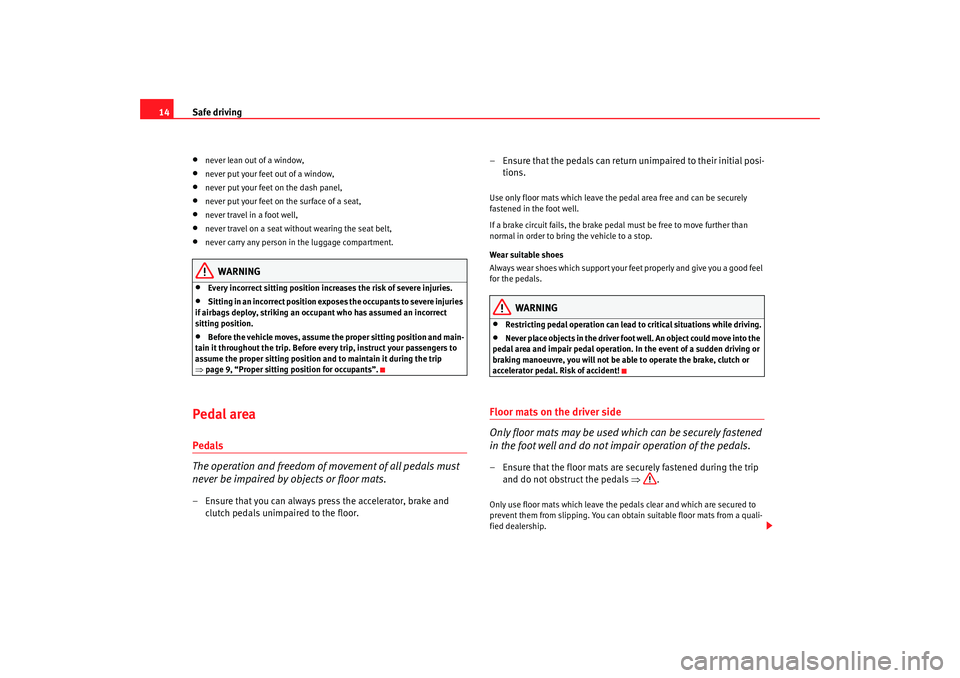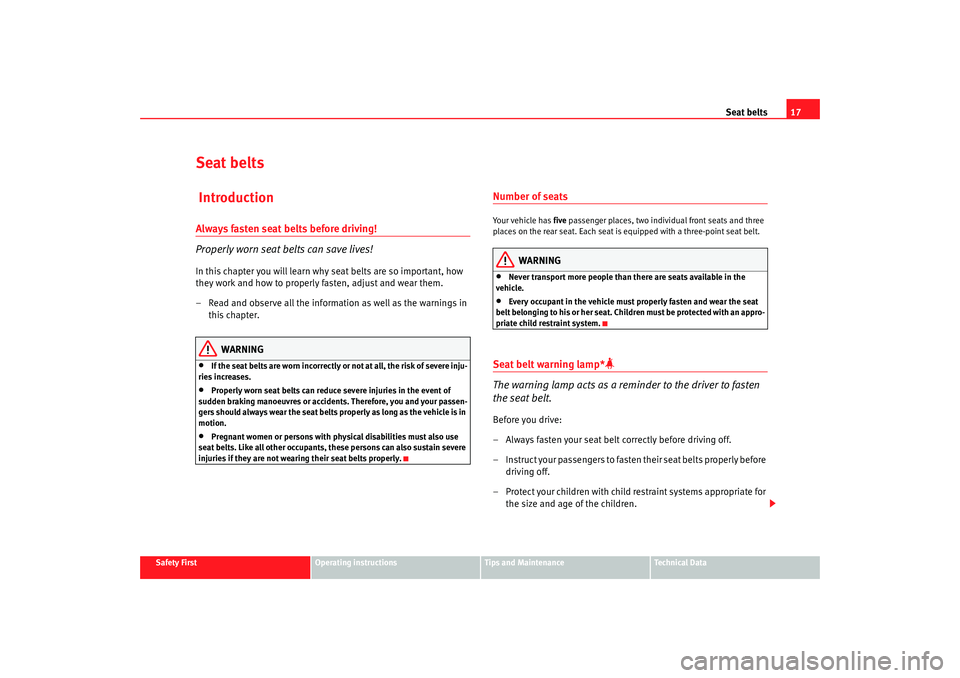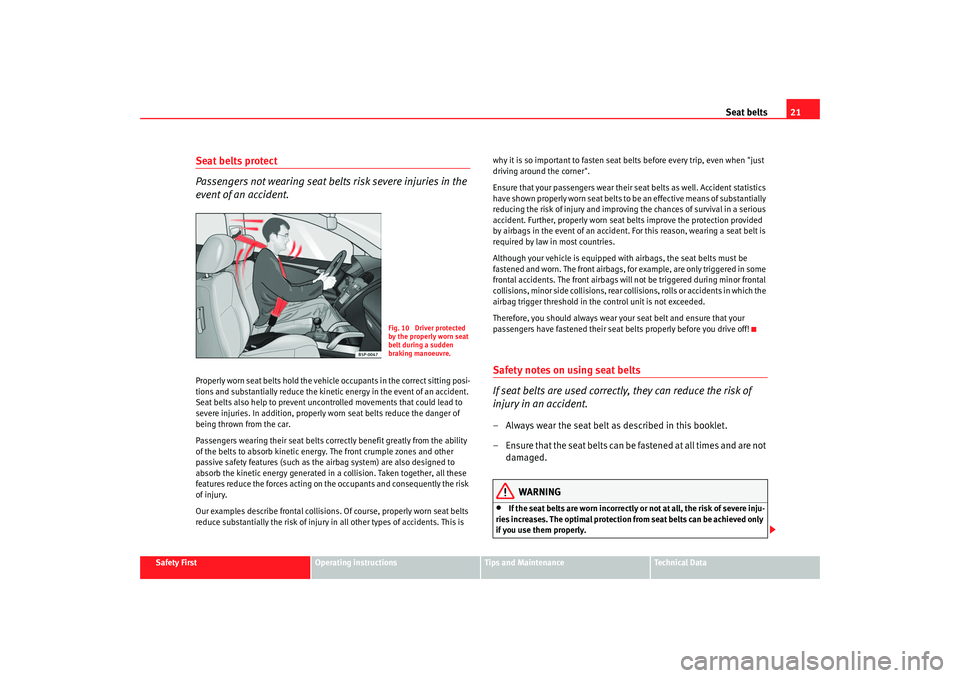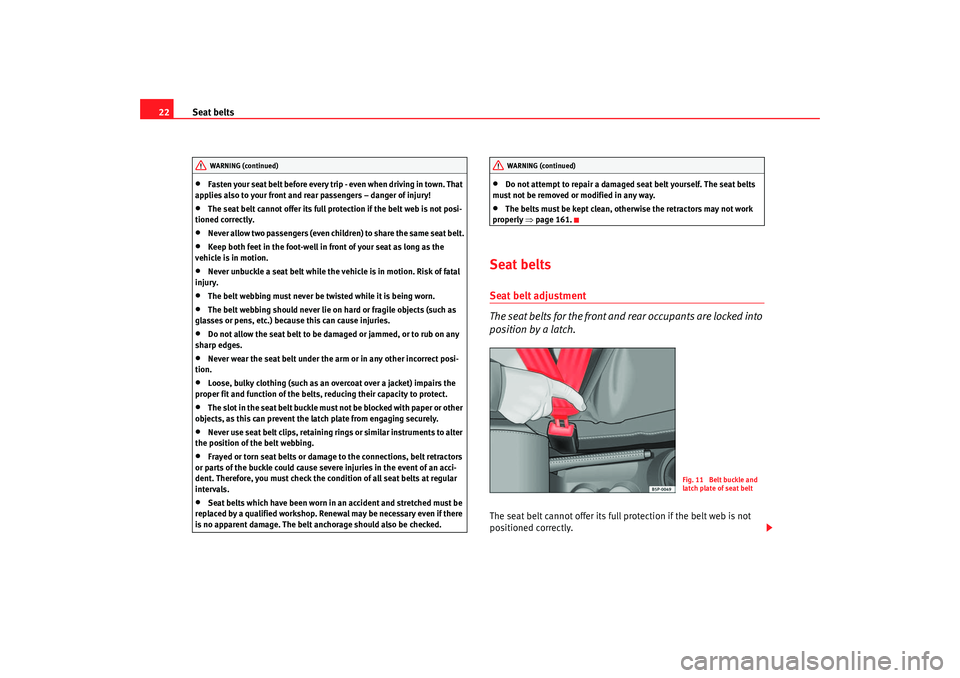2005 Seat Ibiza 5D warning
[x] Cancel search: warningPage 15 of 252

Safe driving13
Safety First
Operating instructions
Tips and Maintenance
Te c h n i c a l D a t a
Centre rear head restraint*The central rear head restraint has 2 positions:• Ra ised position or position for use ⇒ fig. 5. In this position, the head
restraint is used normally, protecting the occupant of the rear central seat,
along with the rear seat belts.•
Rest position ⇒fig. 5 . This position improves the driver's rear visi-
bility.
To fit the head restraint in position for use , pull on the edges with both
hands in the direction of the arrow. To place it in rest position , lower the
head restraint.
WARNING
Whenever a passenger is seated in the rear central seat, the head restraint
should be placed in the position for use .
Note
Note the instructions on the adjustment of the head restraints.Examples of incorrect sitting positions
An incorrect sitting position can lead to severe injuries to
occupants.Seat belts can provide optimal protection only when the belt webs
are properly positioned. Incorrec t sitting positions substantially
reduce the protective function of se at belts and increase the risk of
injury due to incorrect belt web position. As the driver, you are
responsible for all vehicle occupants, especially children.
– Never permit anyone to assume an incorrect sitting position in the vehicle while travelling ⇒ .The following list contains examples of sitting positions that could be
dangerous for all occupants. The list is not complete, but we would like to
make you aware of this issue.
Therefore, whenever the vehicle is in motion:•
Never stand in the vehicle,
•
never stand on the seats,
•
never kneel on the seats,
•
never tilt your backrest far to the rear,
•
never lean against the dash panel,
•
never lie on the rear bench,
•
never sit on the front edge of a seat,
•
never sit sideways,
Fig. 5 Adjusting central
rear head restraint
AA
AB
AA
AB
AA
ibiza_ingles Seite 13 Mittwoch, 5. Oktober 2005 5:17 17
Page 16 of 252

Safe driving
14•
never lean out of a window,
•
never put your feet out of a window,
•
never put your feet on the dash panel,
•
never put your feet on the surface of a seat,
• never travel in a foot well,•
never travel on a seat without wearing the seat belt,
•
never carry any person in the luggage compartment.
WARNING
•
Every incorrect sitting position increases the risk of severe injuries.
•
Sitting in an incorrect position exposes the occupants to severe injuries
if airbags deploy, striking an occupant who has assumed an incorrect
sitting position.
•
Before the vehicle moves, assume the proper sitting position and main-
tain it throughout the trip. Before every trip, instruct your passengers to
assume the proper sitting position and to maintain it during the trip
⇒ page 9, “Proper sitting position for occupants”.
Pedal areaPedals
The operation and freedom of movement of all pedals must
never be impaired by objects or floor mats.– Ensure that you can always press the accelerator, brake and
clutch pedals unimpaired to the floor. – Ensure that the pedals can return unimpaired to their initial posi-
tions.
Use only floor mats which leave the pedal area free and can be securely
fastened in the foot well.
If a brake circuit fails, the brake pedal must be free to move further than
normal in order to bring the vehicle to a stop.
Wear suitable shoes
Always wear shoes which support your feet properly and give you a good feel
for the pedals.
WARNING
•
Restricting pedal operation can lead to critical situations while driving.
•
Never place objects in the driver foot well. An object could move into the
pedal area and impair pedal operation. In the event of a sudden driving or
braking manoeuvre, you will not be ab le to operate the brake, clutch or
accelerator pedal. Risk of accident!
Floor mats on the driver side
Only floor mats may be used which can be securely fastened
in the foot well and do not impair operation of the pedals.– Ensure that the floor mats are securely fastened during the trip and do not obstruct the pedals ⇒.Only use floor mats which leave the pedals clear and which are secured to
prevent them from slipping. You can obta in suitable floor mats from a quali-
fied dealership.
ibiza_ingles Seite 14 Mittwoch, 5. Oktober 2005 5:17 17
Page 17 of 252

Safe driving15
Safety First
Operating instructions
Tips and Maintenance
Te c h n i c a l D a t a
WARNING
•
If the pedals are obstructed, you could cause an accident. Risk of
serious injuries.
•
Ensure that the floor mats are always securely attached.
•
Never lay or fit floor mats or other floor coverings over the original floor
mats. This would reduce the pedal area and could obstruct the pedals. Risk
of accident.
Stowing luggageLoading the luggage compartment
All luggage and other loose object s must be safely secured in
the luggage compartment.Unsecured objects which shift back and forth could impair the
driving safety or driving characteristics of the vehicle by shifting the
centre of gravity.
– Distribute the load evenly in the luggage compartment.
– Lay and stow heavy luggage as far forward as possible in the luggage compartment.
– Stow heavy luggage as low as possible in the luggage compart- ment.
– Secu re heavy objects to the fitted fastening rings ⇒ page 16.
WARNING
•
Loose luggage and other objects in the luggage compartment can
cause serious injuries.
•
Always stow objects in the luggag e compartment and secure them on
the fastening rings.
•
Use suitable specialist straps to secure heavy objects.
•
During sudden manoeuvres or accidents, loose objects can be flung
forward, injuring vehicle occupants. Th is increased risk of injury will be
further increased if a loose object is struck by an inflating airbag. If this
happens, objects can be transformed into “missiles”. Risk of fatal injury.
•
Please note that the centre of gravity may shift when transporting
heavy objects; this may affect the vehicle's handling and lead to an acci-
dent. Therefore, it is essential to adjust your speed and driving style
accordingly, to avoid accidents.
•
Never exceed the allowed axle loads or allowed maximum weight. If the
allowed axle load or the allowed total weight is exceeded, the driving char-
acteristics of the vehicle may change, leading to accidents, injuries and
damage to the vehicle.
•
Never leave your vehicle unattended, especially when the tailgate is
open. Children could climb into the luggage compartment closing the door
behind them; they will remain trapped without help and there is a mortal
risk.
•
Never allow children to play in or around the vehicle. Close and lock
both the tailgate and all the doors when you leave the vehicle. Before you
lock the vehicle, make sure that ther e are no adults or children in the
vehicle.
•
Never transport passengers in the luggage compartment. Every
passenger must be properly belted in ⇒ page 17.
ibiza_ingles Seite 15 Mittwoch, 5. Oktober 2005 5:17 17
Page 18 of 252

Safe driving
16
Note•
Air circulation in the vehicle helps re duce fogging of the windows. Used
air escapes through ventilation slits in the side trim of the luggage compart-
ment. Ensure that the ventilation slits are never covered.
•
Straps for securing the load to the fastening rings are commercially
available.
Fastening rings
There are four fastening rings in the luggage compartment
which can be used to secure luggage and other objects.– Always use suitable and undamaged straps to secure luggage and other objects to the fastening rings ⇒ in “Loading the
luggage compartment” on page 15.
– Pull up the fastening rings to attach the straps.During a collision or an accident, even small and light objects can possess so
much energy that they can cause very severe injuries. The amount of “kinetic
energy” depends on the speed of the vehicle and the weight of the object.
The most significant factor, however, is the speed of the vehicle.
For example: an object weighing 4.5 kg is lying unsecured in the vehicle.
During a frontal collision at a speed of 50 km/h, this object generates a force
corresponding to 20 times its weight. That means that the effective weight of
the object increases to about 90 kg. You can imagine the severity of the inju-
ries which might be sustaine d if this “projectile” strikes an occupant as it flies
through the passenger compartment. This increased risk of injury will be
further increased if a loose object is struck by an inflating airbag.
WARNING
•
If pieces of baggage or other objects are secured to the fastening rings
with inappropriate or damaged retaining cords, injuries could result in the
event of braking manoeuvres or accidents.
•
To prevent pieces of luggage or other objects from flying forward,
always use appropriate retaining cords which are secured to the fastening
rings.
•
Never secure a child seat on the fastening rings.
ibiza_ingles Seite 16 Mittwoch, 5. Oktober 2005 5:17 17
Page 19 of 252

Seat belts17
Safety First
Operating instructions
Tips and Maintenance
Te c h n i c a l D a t a
Seat belts IntroductionAlways fasten seat belts before driving!
Properly worn seat belts can save lives!In this chapter you will learn why seat belts are so important, how
they work and how to properly fasten, adjust and wear them.
– Read and observe all the information as well as the warnings in
this chapter.
WARNING
•
If the seat belts are worn incorrectly or not at all, the risk of severe inju-
ries increases.
•
Properly worn seat belts can reduce severe injuries in the event of
sudden braking manoeuvres or accidents. Therefore, you and your passen-
gers should always wear the seat belts properly as long as the vehicle is in
motion.
•
Pregnant women or persons with physical disabilities must also use
seat belts. Like all other occupants, these persons can also sustain severe
injuries if they are not wearing their seat belts properly.
Number of seatsYour vehicle has five passenger places, two individual front seats and three
places on the rear seat. Each seat is equipped with a three-point seat belt.
WARNING
•
Never transport more people than there are seats available in the
vehicle.
•
Every occupant in the vehicle must properly fasten and wear the seat
belt belonging to his or her seat. Chil dren must be protected with an appro-
priate child restraint system.
Seat belt warning la mp*
The warning lamp acts as a reminder to the driver to fasten
the seat belt.Before you drive:
– Always fasten your seat belt correctly before driving off.
– Instruct your passengers to fasten their seat belts properly before
driving off.
– Protect your children with child restraint systems appropriate for the size and age of the children.
ibiza_ingles Seite 17 Mittwoch, 5. Oktober 2005 5:17 17
Page 20 of 252

Seat belts
18The warning lamp
in the combi-instrument lights up if the driver seat belt
is not fastened when the ignition is switched on. In addition, an acoustic
signal can also be heard for a couple of seconds.
The warning lamp* does not go out until the driver seat belt is fastened
while the ignition is switched on.
ibiza_ingles Seite 18 Mittwoch, 5. Oktober 2005 5:17 17
Page 23 of 252

Seat belts21
Safety First
Operating instructions
Tips and Maintenance
Te c h n i c a l D a t a
Seat belts protect
Passengers not wearing seat belts risk severe injuries in the
event of an accident.Properly worn seat belts hold the vehicle occupants in the correct sitting posi-
tions and substantially reduce the kinetic energy in the event of an accident.
Seat belts also help to prevent uncontrolled movements that could lead to
severe injuries. In addition, properly worn seat belts reduce the danger of
being thrown from the car.
Passengers wearing their s eat belts correctly benefit greatly from the ability
of the belts to absorb kinetic energy. The front crumple zones and other
passive safety features (such as the airbag system) are also designed to
absorb the kinetic energy generated in a collision. Taken together, all these
features reduce the forces acting on the occupants and consequently the risk
of injury.
Our examples describe frontal collisions . Of course, properly worn seat belts
reduce substantially the risk of injury in all other types of accidents. This is why it is so important to fasten seat
belts before every trip, even when "just
driving around the corner".
Ensure that your passengers wear their seat belts as well. Accident statistics
have shown properly worn seat belts to be an effective means of substantially
reducing the risk of injury and improvi ng the chances of survival in a serious
accident. Further, properly worn seat belts improve the protection provided
by airbags in the event of an accident. For this reason, wearing a seat belt is
required by law in most countries.
Although your vehicle is equipped with airbags, the seat belts must be
fastened and worn. The front airbags, for example, are only triggered in some
frontal accidents. The front airbags will not be triggered during minor frontal
collisions, minor side collisions, rear collisions, rolls or accidents in which the
airbag trigger threshold in the control unit is not exceeded.
Therefore, you should always wear your seat belt and ensure that your
passengers have fastened their seat belts properly before you drive off!
Safety notes on using seat belts
If seat belts are used correctly, they can reduce the risk of
injury in an accident.– Always wear the seat belt as described in this booklet.
– Ensure that the seat belts can be fastened at all times and are not damaged.
WARNING
•
If the seat belts are worn incorrectly or not at all, the risk of severe inju-
ries increases. The optimal protection from seat belts can be achieved only
if you use them properly.
Fig. 10 Driver protected
by the properly worn seat
belt during a sudden
braking manoeuvre.
ibiza_ingles Seite 21 Mittwoch, 5. Oktober 2005 5:17 17
Page 24 of 252

Seat belts
22•
Fasten your seat belt before every trip - even when driving in town. That
applies also to your front and rear passengers – danger of injury!
•
The seat belt cannot offer its full prot ection if the belt web is not posi-
tioned correctly.
•
Never allow two passengers (even children) to share the same seat belt.
•
Keep both feet in the foot-well in front of your seat as long as the
vehicle is in motion.
•
Never unbuckle a seat belt while the vehicle is in motion. Risk of fatal
injury.
•
The belt webbing must never be twisted while it is being worn.
•
The belt webbing should never lie on hard or fragile objects (such as
glasses or pens, etc.) because this can cause injuries.
•
Do not allow the seat belt to be da maged or jammed, or to rub on any
sharp edges.
•
Never wear the seat belt under the arm or in any other incorrect posi-
tion.
•
Loose, bulky clothing (such as an overcoat over a jacket) impairs the
proper fit and function of the belts, reducing their capacity to protect.
•
The slot in the seat belt buckle must not be blocked with paper or other
objects, as this can prevent the latch plate from engaging securely.
•
Never use seat belt clips, retaining rings or similar instruments to alter
the position of the belt webbing.
•
Frayed or torn seat belts or damage to the connections, belt retractors
or parts of the buckle could cause severe injuries in the event of an acci-
dent. Therefore, you must check the co ndition of all seat belts at regular
intervals.
•
Seat belts which have been worn in an accident and stretched must be
replaced by a qualified workshop. Renewal may be necessary even if there
is no apparent damage. The belt anchorage should also be checked.
•
Do not attempt to repair a damaged seat belt yourself. The seat belts
must not be removed or modified in any way.
•
The belts must be kept clean, ot herwise the retractors may not work
properly ⇒ page 161.
Seat beltsSeat belt adjustment
The seat belts for the front and rear occupants are locked into
position by a latch.The seat belt cannot offer its full protection if the belt web is not
positioned correctly.
WARNING (continued)
WARNING (continued)
Fig. 11 Belt buckle and
latch plate of seat belt
ibiza_ingles Seite 22 Mittwoch, 5. Oktober 2005 5:17 17